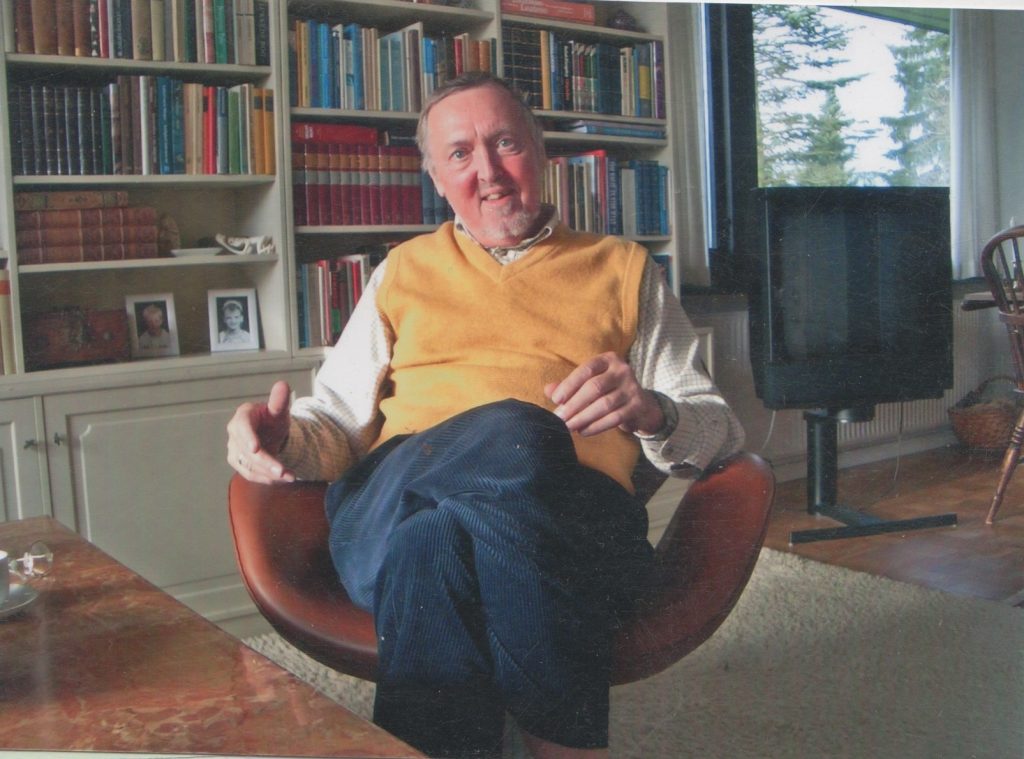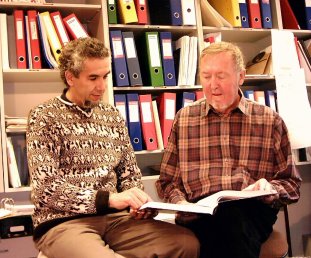 Poul-Erik Paulev
Poul-Erik Paulev
One of the greatest Danish Physiologists
May 30, 1935 – June 25, 2017
In memoriam
I arrived with our two daughters, Natalia and Rafaela to Copenhaguen, Denmark on a chilly July back in 2004, in order to join my wife, Lucrecia De Urioste, who was acting as the 1st Secretary in Charge of Consular Affairs at the Bolivian Embassy. Six months previously, when her destiny to go there, had been set, I contacted through the web, Prof. Pouk-Erik Paulev at the Physiology Dept of the Panum Institute of the University of Copenhaguen. He responded “you are welcome in my lab”. From the Embassy, the following day after my arrival, I called Poul-Erik and we spent over an hour talking about our common interests in science. I immediately realized that I had, on the other side of the line, an extraordinary scientist!!
We talked about Ole Siggaard-Andersen, another Dane, the world’s father of acid-base status in blood, whom I admired greatly and with whom Poul-Erik was working. I was truly delighted and amazed! Many years back I had corresponded with Ole, regarding my interest of Acid-base and had even sent him the first computer interpretation of arterial blood gases and acid-base status, that I had written. So I could hardly believe my luck. At the end of our long telephone conversation, Pool-Erik told me to meet him at his office in the Panum Institute, next day.
When I knocked on his door, I found a tall, kind and a very enthusiastic man, with a pleasant smile who welcomed me effusibely. I immediately felt at home. He opened the door next to his Office and said, “this is your Office”. I could hardly believe it
Three and a half years of very productive pleasant scientific collaboration, ensued. We published joint papers related to high altitude, my specialty, in a country where the highest Point is a 170 m. hill.
I learned so much from him, in regards to scientific rigor, synthesis, pragmatism, simple minded attitudes, all, fundamental traits of superior men.
Shown here, a beautiful image of our collaboration at Panum Institute of Physiology, University of Copenhagen
He had been working on a review paper on the extraordinary achievements of the Danish scientists on acid-base equilibrium. I exposed to him the need to make high altitude corrections for the adequate interpretation in all high altitude cities of the world, a knowledge that would save lives. He became immediately interested and when I finished the calculations and the graphs, he decided to include a section in his review article and changed the title to “Essentials in the diagnosis of Acid-Base Disorders and it’s High Altitude Application“. He offered to put my name as first author and I refused. Then, I came up with the idea of tossing a coin, that upon flipping in the air and dropping to the ground, favored him. We laughed and carried on and write in all, 8 papers together.
You can read here an amusing story on the acid-base analyzer at IPPA.
The subjects were diverse including high altitude diving tables. He came to our III Chronic Hypoxia Symposium with his lovely wife Kirsten. Some photos can be seen here.
His generosity went beyond limits. He wrote a physiology book and put it on-line for free use, by anyone. Later on, he granted me co-authorship and I wrote the High Altitude section. Kirsten McCord, one of his patients had discovered his personality and collaborated with him making the graphs, that are now so famous in many physiology books. She went on to become a lifetime collaborator and friend always visiting Poul-Erik and his lovely wife Kirsten that always greeted us with a smile and great Smorebrød (typical Danish sandwiches) at their enchanting home in Birkerød, right next to the golf course, where Poul-Erik and his wife Kirsten, spent many hours enjoying the fields.
I throughly enjoyed discussion of many aspects of physiology and science in his lab. He told me very interesting stories, like when he was a young man and wrote an article that questioned the concepts of Herman Rahn, who was a notable German physiologist who had moved to US. He pointed out that Herman had not been upset, quite the contrary, he invited Poul-Erik to spend some time in his lab. He also told me that Herman had a small scale in his pocket and ran out everyday from his office to the garden to weigh an egg of a small byrd in his nest, that way he was able to study hydration of the egg. That was a time of superior scientists, that made fantastic advances in science. There was no mediocrity, that my father once referred to as: “a congenital disease, very painful and with no treatment”.
Poul-Erik wrote a beautiful and concise biography. I insisted that it be longer, but he was always precise and to the point. It can be read here. Noteworthy is the fact that he suspected decompression sickness when most thought that there was a toxic effect in the water. It is important to note that while at the Panum Institute, I noticed that many of his colleagues were jealous of his work. They had tried to outs him from his teaching on several occasions, but could not do so because he had so many scientific publications, more than any of his colleagues. When I joined him and we worked together, I noticed a lot of jealousy about his work and I of course had to inherit this unnoble attitude towards him. But to simply spend life together with him, and to share the most beautiful moments together, in science and deep nearly parental friendship, was more than welcome.
Poul-Erik had worked as a young scientist, in the study of rescuing sailors from submarines. He performed many dives in a 20 meter pool specially designed in order to develop rescue techniques. He dived so many times that on one occasion upon coming up too fast he developed the “bends” (decompression sickness), that he referred to as very painful. He was immediately put of a hyperbaric chamber where he had to spend many hours and upon exit, he again presented pains so he returned for some more hours. This stimulated his interest in diving physiology. he wrote several papers, and I joined him in a few. We wrote about high altitude diving in Lake Titicaca and higher lagoons. This lead to the creation of the Poul-Erik Paulev High Altitude Laboratory.
There he wrote a most beautiful, concise and admirable autobiography. We travelled jointly to a meeting in Poland to join his friend Pokorsky of the Polish Science Academy. We also went to a meeting in Berlin. He asked me to replace Bengt Saltin in a course on acid-base in the north of Denmark, where we attended jointly with our wives. Thanks to their generosity we were able to integrate our family in the fascinating life of Danish culture, of which we became great admirers. I even wrote an article on Danish education in the Copenhagen Post.
He came with Kirsten, to the III Chronic Hypoxia Symposium that I organized in Bolivia. I created the Poul-Erik High Altitude Diving Laboratory in our building.
There we also met Pernille, Thomas and Matias, wonderful, wonderful Danés, He had 3 daughters and Kirsten has 2 sons.
I have difficulty expressing, when I write these words, about this extraordinary man, of all his scientific and human greatness!!
Had the world been populated by more people like him, we would all live in Paradise.
I express my profound admiration for his extensive and wisdom filled scientific work, of over 160 articles published in prestigious Journals around the world. Many are available at Researchgate.net. What a great Danish Physiologist he was. He left us on July 2017, when he decided it was time time to leave at 84 years of age after a heroic battle with Parkinson’s Disease.
His legacy is scientific, and I bow to always remind all scientists around the world, about his outstanding achievements.
Prof. Dr. Gustavo Zubieta-Calleja

